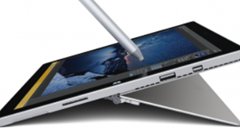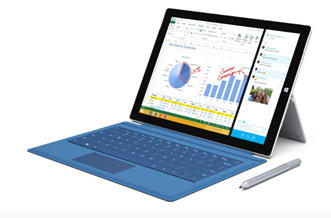Just what the doctor ordered—Surface Pro 3
 Some of you may be wondering why I’ve said so little about the newest member of our Surface family of devices, the Surface Pro 3. To say that, as a physician, I am excited about the Surface Pro 3 and its potential to rock the world for clinicians would be an understatement. But the truth of the matter is that even though I work at Microsoft, I have only had about 15 minutes of hands-on experience with a Surface Pro 3. That occurred during a briefing I was conducting last week for some visiting health system c-suite execs at our Executive Briefing Center on the Microsoft campus here in Redmond. Someone from our Surface team popped into my session to show our guests the Surface Pro 3. It was the first time I’d seen the device as well. Not only was I impressed, but after spending a few minutes with the new tablet, the health system’s CTO commented, “I stopped using my iPad with the Surface Pro 2. I think I’ll be able to ditch my laptop as well with the Surface Pro 3.”
Some of you may be wondering why I’ve said so little about the newest member of our Surface family of devices, the Surface Pro 3. To say that, as a physician, I am excited about the Surface Pro 3 and its potential to rock the world for clinicians would be an understatement. But the truth of the matter is that even though I work at Microsoft, I have only had about 15 minutes of hands-on experience with a Surface Pro 3. That occurred during a briefing I was conducting last week for some visiting health system c-suite execs at our Executive Briefing Center on the Microsoft campus here in Redmond. Someone from our Surface team popped into my session to show our guests the Surface Pro 3. It was the first time I’d seen the device as well. Not only was I impressed, but after spending a few minutes with the new tablet, the health system’s CTO commented, “I stopped using my iPad with the Surface Pro 2. I think I’ll be able to ditch my laptop as well with the Surface Pro 3.”
 Since I haven’t had as much hands-on experience as I would require to write my own review about the Surface Pro 3 ( hint, hint Surface team ) you’ll have to rely on what others have been sayingsince we publically announced the new tablet. Although those reviews have not come from clinicians, most have been very positive. I also know from my own experience with the Surface Pro 2, which I now use as my only machine both in the office and on the road, and from what other clinicians have told us about the pluses and minuses of the Surface Pro 2 in clinical settings, that Surface Pro 3 is going to be big in healthcare. That’s because it solves for just about all of the weakness that can be found in the earlier devices. It has more screen real estate, higher screen resolution, more power, longer battery life, better kick-stand, better stylus, better keyboard, and is thinner and lighter. And, it will run the socks off of any app or clinical solution you wish to use.
Since I haven’t had as much hands-on experience as I would require to write my own review about the Surface Pro 3 ( hint, hint Surface team ) you’ll have to rely on what others have been sayingsince we publically announced the new tablet. Although those reviews have not come from clinicians, most have been very positive. I also know from my own experience with the Surface Pro 2, which I now use as my only machine both in the office and on the road, and from what other clinicians have told us about the pluses and minuses of the Surface Pro 2 in clinical settings, that Surface Pro 3 is going to be big in healthcare. That’s because it solves for just about all of the weakness that can be found in the earlier devices. It has more screen real estate, higher screen resolution, more power, longer battery life, better kick-stand, better stylus, better keyboard, and is thinner and lighter. And, it will run the socks off of any app or clinical solution you wish to use.
With such a new device, the evidence for clinical use is just starting to emerge. One of the chosen few organizations that has had an early look is Seattle Children’s Hospital. Anyone who lives around here knows and loves this outstanding pediatric institution. During my tenure as the CIO and CMIO for a neighboring hospital, I got know Children’s former CIO, Drex DeFord (now CEO of Next Wave Connect) and his then understudy, Wes Wright, who now serves as Children’s Senior VP and CIO. Both are visionary leaders. I would also state that as an organization Seattle Children’s is both socially conscious and highly pragmatic about the choices it makes. So the fact that Wes and his team are so enthusiastic about the potential of Surface Pro 3 for clinicians at Seattle Children’s, enough so that they have placed a large order for the devices, is all you really need to know.
Our Surface team just released a new video about the preliminary experience at Seattle Children’s. You can watch it below. The hospital, a Cerner shop, had already been doing some very good work with Microsoft partner VitalHub and clinicians from Pediatric Associates, a large pediatric provider group, using our Surface 2 devices. I’ll be sure to keep you informed as Seattle Children’s and other top healthcare institutions begin to share more about their experiences with the Surface Pro 3.
This article was originally published here.